Related Research Articles

De Anza College is a public community college in Cupertino, California. It is part of the Foothill-De Anza Community College District, which also administers Foothill College in nearby Los Altos Hills, California. The college is named after the Spanish explorer Juan Bautista de Anza.

The Tech Interactive is a science and technology center that offers hands-on activities, labs, design challenges and other STEAM education resources. It is located in downtown San Jose, California, adjacent to the Plaza de César Chávez.
The Arts Council Silicon Valley (1982–2013) was the official Santa Clara County, United States arts council.

The San Jose Museum of Quilts & Textiles is an art museum in Downtown San Jose, California, USA. Founded in 1977, the museum is the first in the United States devoted solely to quilts and textiles as an art form. Holdings include a permanent collection of over 1,000 quilts, garments and ethnic textiles, emphasizing artists of the 20th- and 21st-century, and a research library with over 500 books concerning the history and techniques of the craft.
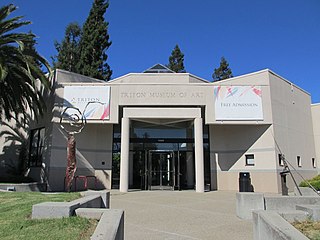
The Triton Museum of Art is a contemporary art museum located at 1505 Warburton Avenue in Santa Clara, California.
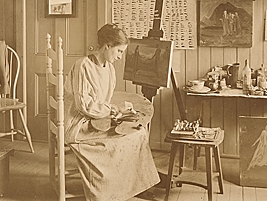
Agnes Lawrence Pelton (1881–1961) was a modernist painter who was born in Germany and moved to the United States as a child. She studied art in the United States and Europe. She made portraits of Pueblo Native Americans, desert landscapes and still lifes. Pelton's work evolved through at least three distinct themes: her early "Imaginative Paintings," art of the American Southwest people and landscape, and abstract art that reflected her spiritual beliefs. She was a first cousin of American sculptor Laura Gardin Fraser.

The Institute of Contemporary Art San José (ICA) is a nonprofit art center and gallery founded in 1980, and located in the SoFA District of Downtown San Jose, California, U.S. It supports contemporary artists working in painting, printmaking, sculpture, photography, new media works and site-specific installations. ICA San José is member and community supported. The art center offers rotating art exhibitions with free admission, along with public programs, education programs, and community events.
Terry Acebo Davis is a Filipino American artist and nurse based in the San Francisco Bay Area. Her art is thematically linked to her family and her origins as a Filipino American.
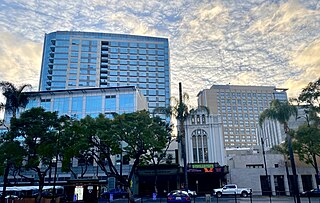
SoFA is an arts, cultural, and entertainment district of Downtown San Jose, California. Home to numerous cultural institutions, art galleries, and theatre companies, including the Institute of Contemporary Art San José, the San José Opera, and the Silicon Valley Symphony, SoFA bills itself as "Silicon Valley's Creative District".
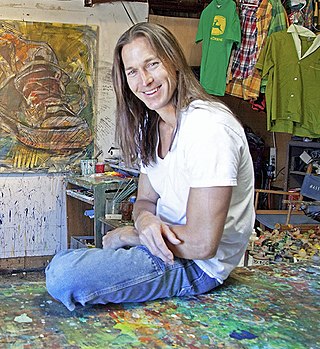
Gordon Keith Smedt is an American painter from the San Francisco Bay Area. Smedt is known for his Pop art portraits of inanimate objects. His work is characterized by bold, colorful depictions of everyday objects on large canvases. He lives and works in Los Gatos, California.
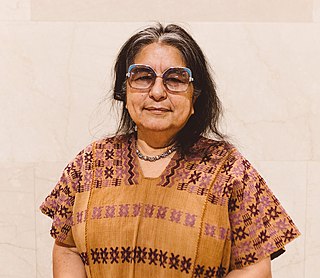
Consuelo Jiménez Underwood is an American fiber artist, known for her pieces that focus on immigration issues. She is an indigenous Chicana currently based in Cupertino, California. As an artist she works with textiles in attempt to unify her American roots with her Mexican Indigenous ones, along with trying to convey the same for other multicultural people.

Deborah Kennedy is an American author, educator and artist whose work has focused primarily on environmental advocacy and ecological concerns. She has also lectured on art and art history at Santa Clara University and San Jose City College. She has received attention in media for her art projects, most notably along the Berlin Wall before its fall in November 1989.

M. Louise Stanley is an American painter known for irreverent figurative work that combines myth and allegory, satire, autobiography, and social commentary. Writers such as curator Renny Pritikin situate her early-1970s work at the forefront of the "small, but potent" Bad Painting movement, so named for its "disregard for the niceties of conventional figurative painting." Stanley's paintings frequently focus on romantic fantasies and conflicts, social manners and taboos, gender politics, and lampoons of classical myths, portrayed through stylized figures, expressive color, frenetic compositions and slapstick humor. Art historians such as Whitney Chadwick place Stanley within a Bay Area narrative tradition that blended eclectic sources and personal styles in revolt against mid-century modernism; her work includes a feminist critique of contemporary life and art springing from personal experience and her early membership in the Women's Movement. Stanley has been awarded a Guggenheim Fellowship and grants from the Pollock-Krasner Foundation, Adolph and Esther Gottlieb Foundation, and National Endowment for the Arts. Her work has been shown at institutions including PS1, San Francisco Museum of Modern Art (SFMOMA), The New Museum and Long Beach Museum of Art, and belongs to public collections including SFMOMA, San Jose Museum of Art, Oakland Museum, and de Saisset Museum. Stanley lives and works in Emeryville, California.
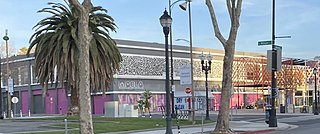
Movimiento de Arte y Cultura Latino Americana (MACLA) is a contemporary arts space focused on the Chicano and Latino experience and history, located in the SoFA district at 510 South First Street in San Jose, California. The museum was founded in 1989, in order to encourage civic dialog and social equity. The current programming includes visual art, performing and literary arts, youth arts education, and a community art program. The space has two performing arts spaces, a gallery and the MACLA Castellano Playhouse and they frequently host poetry readings and film screenings.
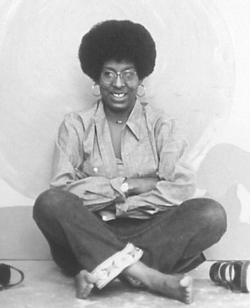
Ruth Tunstall Grant (1945–2017) was an African American artist, educator and activist in the San Francisco Bay Area known for her paintings, community activism, and arts advocacy. Her work has been featured in many invitational group exhibitions as well as solo shows at national and international venues such as Dallas Museum of Fine Art, Dallas, Texas; Rath Museum, Geneva, Switzerland; Triton Museum of Art, Santa Clara, California; San Jose Museum of Art, San Jose, California; and Los Gatos Museum of Art, Los Gatos, California. She had a strong focus on community service and advocacy of children’s rights and social justice in and beyond Santa Clara County. She established many innovative, ongoing arts programs and inspired creative activists, such as Marita Dingus.
WORKS/San José is a nonprofit, member-run art space, located in the SoFA district of San Jose, California. It was founded in 1977 by community members.
The Sanchez Art Center is a nonprofit arts organization located in Pacifica, California. It was formed in 1996 by local artists and community members.

Linda Gass is an American environmental activist and artist known for brightly colored quilted silk landscapes, environmental works, and public art sculptures, which reflect her passion for environmental preservation, water conservation and land use.

Jacqueline Thurston is a California-based visual artist and writer. She is most known for evocative photographs that explore the human psyche, the nature of illusion, life and death, and primal forces of nature. Her work also extends to drawings, performance, prose and poetry. Her black and white photographic series of the 1970s and 1980s were identified as early examples of a movement toward "psychological documentary" and noted for their ambiguity, sense of stillness and silence, and nuanced use of tone, texture and light to convey mood. In the 1990s, she began to work in color, frequently pairing photographs with the written word, in talismanic "photo objects," artist books and her book and series, Sacred Deities of Ancient Egypt (2019). These works explored shamanistic connections to nature, the creative process in relation to memory, dream and autobiography, and the psychoanalytic roots of symbol and metaphor.
References
- 1 2 Wylde, Nanette (2017). "Whirligig Interview : Jan Rindfleisch". Whirligig. Retrieved 2021-05-28.
- ↑ Wykes, S. L. (1986-04-23). "Gallery Chief Wants 'Euphrat' to Be Common Word" . San Jose Mercury News .
- ↑ "Artnet News: Ambra Medda leaves Design Miami, Banksy does band art, Charles Saatchi's "Newspeak" - artnet Magazine". www.artnet.com. Retrieved 2021-05-28.
- ↑ Bauer, Bernard (1988-01-20). "Cupertino Tiptoes into the World of Art : Fledgling Panel Explores a Growing City's Options" . San Jose Mercury News.
- ↑ Wykes, S. L. (1986-10-08). "Show Sheds Light into Darkroom" . San Jose Mercury News.
- ↑ Wykes, S.L. (1987-03-25). "Stitches in Time Political Quilts Embroider Women's History" . San Jose Mercury News.
- ↑ Burkhart, Dorothy (1987-03-27). "Quilts Current and Historic Expand the Viewer's Political Consciousness Stitches Put Ideas on the Line" . San Jose Mercury News.
- ↑ Burkhart, Dorothy (1991-03-15). "Looking at Freedom in the Land of the Free : Often-Didactic Show Provokes Political Thought" . San Jose Mercury News.
- ↑ DeTran (1988-02-10). "War on Exhibit Through Eyes of Refugees" . San Jose Mercury News.
- ↑ Jung, Carolyn (1994-11-29). "Art Reflects Immigrant Suffering" . San Jose Mercury News.
- ↑ Burkhart, Dorothy (1990-01-25). "Painting an Honest Picture of Age" . San Jose Mercury News.
- ↑ Fischer, Jack (2001-05-06). "Artistic Distinction in Tech Capital" . San Jose Mercury News.
- ↑ Wilson, Matt (2010-05-05). "Museum Focuses on the Games of Life" . San Jose Mercury News.
- ↑ Baum, Hank (1981). The California Art Review. Millbrae, Calif.: Celestial Arts/Krantz. ISBN 0890873100.
- ↑ Curtis, Cathy (1985-03-10). "Art Collectors in and Around Silicon Valley". The San Francisco Examiner. Retrieved 2021-06-20.
- ↑ Felciano, Rita (1987-03-01). ""The Power of Cloth": A Potent Patchwork of Political Quilts". The San Francisco Examiner. Retrieved 2021-06-20.
- ↑ Roder, Sylvie (1984-03-31). "Not "For Eyes Only"". Artweek. 15 (13): 6 – via Internet Archive.
- ↑ Monaco, Paul; Davis, Murwani (1990). Art around the Bay: a guide to art galleries and museums in the San Francisco Bay Area. Cupertino, Calif.: Trumpetvine Pr. ISBN 9780962764912.
- ↑ "Awakenings: An Untold Backstory of the Agnes Pelton Renaissance | by Jan Rindfleisch". California Desert Art by Ann Japenga. 2019-08-22. Retrieved 2021-05-28.
- ↑ "Creative Power: The Art and Activism of Ruth Tunstall Grant". Ginger Press. 2019. Retrieved 2021-04-08.
- ↑ "Roots and Offshoots: Silicon Valley's Arts Community". Ginger Press. 2017. Retrieved 2021-04-04.
- ↑ "Art Science Evenings in Silicon Valley". www.scaruffi.com. Retrieved 2021-05-28.
- ↑ "Literary event lineup highlights local writers, issues". The Mercury News. 2017-12-18. Retrieved 2021-05-28.
- ↑ Agnes Pelton : desert transcendentalist. Gilbert Vicario, Erika Doss, Michael Zakian, Elizabeth Armstrong, Susan L. Aberth, Rachel Sadvary Zebro. Munich, Germany. 2019. ISBN 978-3-7774-3192-5. OCLC 1048948103.
{{cite book}}: CS1 maint: location missing publisher (link) CS1 maint: others (link) - ↑ Estersohn, Betty, Jan Rindfleisch and Deanna Bartels. "Agnes Pelton” in Staying Visible: The Importance of Archives, 1981.
- ↑ "Metroactive Arts | WORKS/SJ". www.metroactive.com. Retrieved 2021-05-28.
- ↑ Burkhart, Dorothy (1987-10-30). "Lively Display, Varying Media at De Anza Exhibit, the First Funded By Cupertino Arts Group Gifted Alumni Boost Show" . San Jose Mercury News.
- ↑ "California Studies Conference XIX". www.irle.berkeley.edu. Retrieved 2021-05-28.
- ↑ "History/Resume". weadartists. Retrieved 2021-05-28.
- ↑ Rindfleisch, Jan (1986-07-20). "Racist Message in Whitewashing Art" . San Jose Mercury News.
- ↑ Tromble, Meredith (1992-04-23). "Responding to Difference: Women's Caucus for Art Conference". Artweek. 24 (14): 13 – via Internet Archive.
- 1 2 "Jan Rindfleisch of Euphrat Museum | Women of Influence 2014". www.bizjournals.com. Retrieved 2021-06-22.
- ↑ Cupertino CityChannel (2017-07-15), Cupertino Civic Service Awards 1988 , retrieved 2021-05-28
- ↑ "11 Receive Awards in S.J. as Women of Achievement" . San Jose Mercury News. 1989-05-11.
- ↑ "Ginger Press - About". www.gingerpressbooks.com. Retrieved 2021-06-07.
- ↑ "Triton's Rivera Recognized". Artweek. 23 (27): 3. 1992-11-05 – via Internet Archive.
- 1 2 3 4 5 "Publications". Euphrat Museum. Retrieved 2021-05-28.
- ↑ Chiarmonte, Paula L (1990). Women artists in the United States: a selective bibliography and resource guide on the fine and decorative arts, 1750–1986. Boston, Mass: G.K. Hall. p. 214. ISBN 0-8161-8917-X.
- ↑ Lippard, Lucy R (1990). Mixed Blessings : New art in a multicultural America. New York: Pantheon. p. 269. ISBN 9780679729662.
- ↑ Galpin, Amy (2012). Behold, America! : Art of the United States from Three San Diego Museums. San Diego, California: San Diego Museum of Art. ISBN 9780937108499.
- ↑ Chamberlain, Marcia (1984). CADRE 84. San Jose, California: San Jose State University Art Department. pp. 5–13.
- ↑ Rindfleisch, Jan (1986). The First San Jose Biennial. San Jose, California: San Jose Museum of Art. pp. 2–10. ISBN 0938175-00-9.
- ↑ Women's Caucus for Art, Southern Exposure Gallery (1987). Beyond Power: A Celebration. San Francisco, California: Southern Exposure Gallery. p. 19.
- ↑ Rindfleisch, Jan (1987). "Symbolic Rituals". Irregular Gazette.
- 1 2 "Jan Rindfleisch author search". Bolerium Books. Retrieved 2021-04-08.
- ↑ "The Art of Jean LaMarr". Nevada Museum of Art. Retrieved 2021-11-05.
- ↑ "Staying Visible: How a Small-Town Couple Boosted Agnes Pelton's Star | by Jan Rindfleisch". California Desert Art by Ann Japenga. 2022-05-29. Retrieved 2022-05-30.
- ↑ "Entanglements – a curated collection of contemporary culture" . Retrieved 2022-11-07.